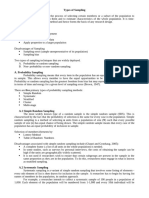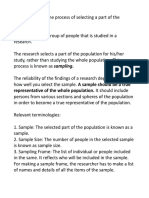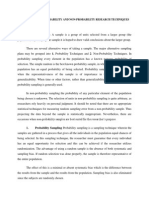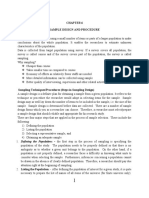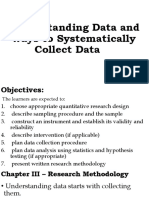0 ratings0% found this document useful (0 votes)
13 views9
9
Uploaded by
lloydsemolavaCopyright:
© All Rights Reserved
Available Formats
Download as PPTX, PDF, TXT or read online from Scribd
9
9
Uploaded by
lloydsemolava0 ratings0% found this document useful (0 votes)
13 views54 pagesCopyright
© © All Rights Reserved
Available Formats
PPTX, PDF, TXT or read online from Scribd
Share this document
Did you find this document useful?
Is this content inappropriate?
Copyright:
© All Rights Reserved
Available Formats
Download as PPTX, PDF, TXT or read online from Scribd
Download as pptx, pdf, or txt
0 ratings0% found this document useful (0 votes)
13 views54 pages9
9
Uploaded by
lloydsemolavaCopyright:
© All Rights Reserved
Available Formats
Download as PPTX, PDF, TXT or read online from Scribd
Download as pptx, pdf, or txt
You are on page 1of 54
Sampling Techniques
A. TECHNICAL TERMS USED IN RESE ARCH SAMPLING
What is Sampling?
Sampling is a process through which a researcher
selects a portion or segment from the population at
the center of the researcher’s study (Cristobal,
2017).
Sampling is done for any or all of the following reasons (Caintic
& Cruz, 2008):
1. due to limitations of time, money or personnel, it is
impossible to study every item in the population;
2. examining an item may require that the item be destroyed;
3. samples due to its small size can be thoroughly
Sampling is done for any or all of the following reasons (Caintic
& Cruz, 2008):
4. fewer errors are encountered in the collection and handling
of data; and
5. the study of a larger or more varied population can be
carried out at a lesser cost
Population VS. Sample
a. A population is the totality of all values (or measurements)
of a particular characteristic for a specified group of objects
that are interest to the researcher. A population is composed
of individuals called as elements or units
Population VS. Sample
There are two groups of population:
1. Target population- is composed of the entire
group of people or objects to which the researcher
wishes to generalize the findings of the study;
Population VS. Sample
There are two groups of population:
2. Accessible population- a portion of the
population to which the researcher has reasonable
access.
For example:
In a study about the common difficulties encountered by senior
high school students in their first semester of school year 2019-
2020, the target population may be all senior high school students
in Bukidnon. However, the researcher may have access only to
the students of a specific school—these students comprise the
accessible population.
A sample is a finite portion of a population
that will be used or investigated in the study.
It serves as a representative for the entire
population
Researchers commonly select samples for study rather
than the entire population due to constraints in budget,
time, and manpower.
A good sample should be representative of the
population, such that the characteristics of the population
—especially those pertinent to the study— are reflected
in the sample with a fair amount of accuracy.
In the example given, though the accessible
population is a specific school, the researcher
selects specific classes/ sections as sample to
represent the entire school.
Subjects VS Respondents
The individual participants in the study are often
referred to as subjects or respondents. The subjects
are individuals or entities which serve as the focus
of the study.
For example: a researcher, examining all marriages in the
Philippines in the year 2016, wants to find a particular
parameter—the mean age of all the men in those marriages.
From a sample of 1000 subjects, she obtains a sample mean
of 31 years—this figure is a statistic. Using this figure, she
concludes that the mean age of Filipino men who married in
2016 is likely to be close to 31, as well.
Various Approaches
to
Determining the Sample
Sample sizes as small as 30 are generally
adequate to ensure that the sampling distribution
of the mean will approximate the normal curve
(Shott, 1990).
When the total population is equal to or less
than 100, this same number may serve as the
sample size. This is called universal sampling
.
A census study occurs if the entire population
is very small or it is reasonable to include the
entire population (for other reasons). It is called a
census sample because data is gathered on every
member of the population
According to Gay (1976), the following are
acceptable sizes for different types of research:
a. Descriptive research—10% (or sometimes to
20%) may be required.
b. Comparative research- 15 subjects or
groups
5. Slovin’s formula is used to compute for sample
size (Sevilla, 2003):
Where: n—a sample size N—population size e—desired margin of error (1%,
2%, 5%, 10%)
Example: The population total is 8,000 with a desired 2% margin of error.
SAMPLING TECHNIQUES
There are two types of sampling: The probability
sampling and the non-sampling. When the selection of
items is done according to some chance mechanism.
where the elements have an equal chance of being
selected, it is a probability sampling However, if the
items are selected by judgment where elements do not
have an equal chance of being taken, non-probability.
Probability Sampling
Probability sampling is a type of sampling in which all
the members of an entire population have a chance of
being selected. This is also called as scientific sampling
and is mostly used in quantitative researches. The
following are the various methods of probability
sampling:
a. Simple Random Sampling
This is a method of choosing samples in which all the
members of the population are given equal chance of
being selected. It is an unbiased way of selection, as
samples are drawn by chance.
a. Simple Random Sampling
There are various ways of obtaining samples
through simple random sampling (Treece & Treece,
1986). These include the roulette wheel, lottery method,
fishbowl method, and the use of a table of random
numbers.
b. Systematic Sampling
A method of selecting every nth element of a
population. After the required sample size has been
calculated, every nth record is selected from a list of
population members. As long as the list does not
contain any hidden order, this sampling method is as
good as the random sampling method.
b. Systematic Sampling
nth element - A sampling process of selecting every
third record, or every tenth record, or every 20th
respondent, etc.
To determine the nth interval, divide the total
number of sampling units (respondents) by the number
of records that will need to be selected to achieve the
desired number of completed interviews.
c. Stratified Random Sampling
In stratified random sampling, the population is first
divided into different ‘strata’ and then the sampling
follows. Age, gender, and educational qualifications are
some possible criteria used to divide a population into
strata.
c. Stratified Random Sampling
In stratified random sampling, the population is first
divided into different ‘strata’ and then the sampling
follows. Age, gender, and educational qualifications are
some possible criteria used to divide a population into
strata.
For example:
A researcher will study that common effects of smoking on
high school students. The researcher decides to
select equal numbers from the freshman, sophomore, junior,
and senior levels.
The researcher decided to divide the students into strata
based on their year level before proceeding to random/
systematic sampling.
d. Cluster Sampling
Cluster sampling is used in large-scale studies,
where the population is geographically spread out. This
is the most economical ways of obtaining a sample for
a survey. It consists of selecting clusters of units in a
population and then obtaining a simple random sample
of these clusters.
Using a city map, we could divide the entire city
into clusters or blocks of households. Then, a simple
random sample of clusters could be obtained.
Non- Probability Sampling
Is a process of selecting respondents in which
not all members of the entire population are given
a chance to be selected as samples.
This is also called as non-scientific sampling.
a. Convenience Sampling:
This is also called accidental or incidental
sampling. Sometimes, a sample is very hard to
obtain. In cases like these, some researchers
resort to obtaining samples that are easily
accessible. This type of sample is called a
convenience sample because the sample is
convenient to obtain .
Examples of this type of sample are the
following:
1. A professor who uses his physics class to obtain a
sample of college students.
2. An election researcher who obtained a sample of
voters by interviewing people at a shopping center
3. The researcher intends to study the elementary
students of a particular school, but due to the study’s
constraints, the elementary pupils who are present at
the time of the researcher’s visit to the school are
automatically chosen as respondents.
b. Purposive Sampling/ Judgmental Sampling:
This involves handpicking subjects, usually to suit
very specific intentions. Judgment sampling is a
common nonprobability method.
The sample is selected based upon judgment. When
using this method, the researcher must be confident that
the chosen sample is truly representative of the entire
population.
Example: In a study about honor students, the
researcher uses a list of honor students and chooses
the necessary number of respondents, to the
exclusion of all other students.
c. Quota Sampling:
Quota sampling is somewhat similar to stratified
sampling, in that the population is divided into strata,
and the researcher deliberately sets specific proportions
in the sample, whether or not the resulting proportion is
reflective of the total populations.
This is commonly done to ensure the inclusion of a
particular segment of the population.
Example: A group of employees is gathered for a
research, using the strata (quota): Male, above 50,
the sample is trimmed down. From this set of
elements, convenient sampling or judgment sampling
is used to choose for samples or respondents for the
study.
Steps in quota sampling: First, identify the stratums
and their proportions as they are represented in the
population. Then, convenience or judgment sampling
is used to select the required number of subjects
from each stratum.
d. Snowball Sampling:
Snowball sampling is a special nonprobability
method used when the desired sample characteristic
is rare. It may be extremely difficult or cost-
prohibitive to locate respondents in these situations.
This technique relies on referrals from initial
subjects to generate additional subjects. It lowers
search costs; however, it introduces bias because the
technique itself reduces the likelihood that the sample
will represent a good cross-section of the population.
THANK
YOU
Juliana Silva | University of Aldenaire | 2024
You might also like
- Basics of Social Research 7Th Edition Babbie Test Bank Full Chapter PDFDocument37 pagesBasics of Social Research 7Th Edition Babbie Test Bank Full Chapter PDFhoangsang9my43100% (19)
- Describing Sample Size and Sampling ProceduresDocument17 pagesDescribing Sample Size and Sampling ProceduresJoyce Bondoc100% (1)
- LECTURE NOTES (Sampling For Research)Document3 pagesLECTURE NOTES (Sampling For Research)engr.emmancristoNo ratings yet
- Population Sample and Sampling MethodsDocument5 pagesPopulation Sample and Sampling MethodsGrace nyangasiNo ratings yet
- Hand Outs Lesson 16 Pr2Document5 pagesHand Outs Lesson 16 Pr2Kristina CassandraNo ratings yet
- MPC 005 RM Assignment - 2Document14 pagesMPC 005 RM Assignment - 2Arshiya KocharNo ratings yet
- Population and SampleDocument5 pagesPopulation and SampleDesi PuspitasariNo ratings yet
- Types of Sampling Lecture NotesDocument4 pagesTypes of Sampling Lecture Notesclaire olitresNo ratings yet
- SamplingDocument7 pagesSamplingrmdn32529732No ratings yet
- Report Mwalimu11Document6 pagesReport Mwalimu11Zawadi Ally NkulikwaNo ratings yet
- Unit-3rd RMDocument31 pagesUnit-3rd RMamanwp01No ratings yet
- Chap4 PR2 Understanding Data and Ways To Collect DataDocument5 pagesChap4 PR2 Understanding Data and Ways To Collect DataAllyssa RuiNo ratings yet
- Chapter 3.2-Sampling & Sampling DesignDocument34 pagesChapter 3.2-Sampling & Sampling DesignStivanos HabtamuNo ratings yet
- Sampling: Prepared By: Nandini Biswas Assistant Professor of Law, UPESDocument19 pagesSampling: Prepared By: Nandini Biswas Assistant Professor of Law, UPESHasta la VistaNo ratings yet
- Givn To StudentsDocument11 pagesGivn To StudentsagbogoodnessNo ratings yet
- Pangilinan - Rodel - Med001 - Final RequiremnetsDocument3 pagesPangilinan - Rodel - Med001 - Final Requiremnetspangilinanrodel0No ratings yet
- Lecture 2 Finals Sampling Techniques and The SampleDocument2 pagesLecture 2 Finals Sampling Techniques and The SampleAmina SuyaNo ratings yet
- Statistical NotesDocument4 pagesStatistical NotesFawadsubhan JalilNo ratings yet
- Classification of Sampling (Probability Based) (Cresswell)Document33 pagesClassification of Sampling (Probability Based) (Cresswell)muhammadnadeempk0173No ratings yet
- RM - Test 2 PreparationDocument9 pagesRM - Test 2 Preparationrinor ahmetiNo ratings yet
- SamplingDocument6 pagesSamplingsoniaacio84No ratings yet
- Chapter 5 Sampling MethodsDocument20 pagesChapter 5 Sampling MethodsanuragroyNo ratings yet
- Sampling TechniquesDocument15 pagesSampling TechniquesEqaza JavedNo ratings yet
- Definition of Assessing TermsDocument11 pagesDefinition of Assessing TermsKukan NallapenNo ratings yet
- Sampling ProcedureDocument15 pagesSampling Procedurevanne cando100% (1)
- Sampling MethodsDocument6 pagesSampling Methods'Sari' Siti Khadijah HapsariNo ratings yet
- Sampling ProcedureDocument4 pagesSampling ProcedureCassandra ArgelNo ratings yet
- Sampling Design - Group ThreeDocument38 pagesSampling Design - Group ThreeWasihunNo ratings yet
- Sampling Methods 5Document31 pagesSampling Methods 5akoeljames8543No ratings yet
- Sampling in ResearchDocument15 pagesSampling in Researchijazaqsa450No ratings yet
- Sampling Method in ThesisDocument37 pagesSampling Method in ThesisUsama KHanNo ratings yet
- Research - Sampling Methods and TechniquesDocument7 pagesResearch - Sampling Methods and TechniquesRostanica ViloriaNo ratings yet
- Chapter III - Sampling For ResearchDocument24 pagesChapter III - Sampling For ResearchSrinadh NaikNo ratings yet
- 9th Lecture QuestionnaireDocument45 pages9th Lecture QuestionnaireshrabantncNo ratings yet
- Tehnik Sampel&penyiapan DataDocument5 pagesTehnik Sampel&penyiapan DataFerial FerniawanNo ratings yet
- Stat II Chapter 1 and 2Document31 pagesStat II Chapter 1 and 2habtamubiniam897No ratings yet
- Sampling in Quantitative Studies: Basic Sampling Concepts 1. PopulationDocument11 pagesSampling in Quantitative Studies: Basic Sampling Concepts 1. Populationavinash dhameriyaNo ratings yet
- BSRM AssignmentDocument19 pagesBSRM AssignmentKaran NanchahalNo ratings yet
- Sampling: Arathi Sivaram Research Scholar DCMS, University of Calicut Dr. Satheesh E.K Registrar University of CalicutDocument47 pagesSampling: Arathi Sivaram Research Scholar DCMS, University of Calicut Dr. Satheesh E.K Registrar University of CalicutArathi SivaramNo ratings yet
- MR Unit 2Document14 pagesMR Unit 2pradeepkumarbhurandaNo ratings yet
- CN 16 Population Sample and Sample MethodDocument4 pagesCN 16 Population Sample and Sample MethodMyk PagsanjanNo ratings yet
- Pr2 - Sampling ProcedureDocument44 pagesPr2 - Sampling ProcedurecjulianajinNo ratings yet
- Sample Definition: A Sample Is A Group of Units Selected From A Larger Group (TheDocument7 pagesSample Definition: A Sample Is A Group of Units Selected From A Larger Group (Theaqsa_sheikh3294No ratings yet
- ResearchDocument7 pagesResearchNjogu Simon BaseNo ratings yet
- PR2 Q2 W1 3describing Sample Size and Sampling ProceduresDocument26 pagesPR2 Q2 W1 3describing Sample Size and Sampling ProceduresYanieka MirafloresNo ratings yet
- Chapter 6 SamplingDocument5 pagesChapter 6 SamplingAsaminow GirmaNo ratings yet
- Population and SamplingDocument10 pagesPopulation and SamplingDeborah PatrickNo ratings yet
- SamplingDocument33 pagesSamplingsakshichitkaraNo ratings yet
- Chapter 3 Sampling MethodsDocument46 pagesChapter 3 Sampling Methodstemesgen yohannesNo ratings yet
- PR1 Week 2 NoteDocument2 pagesPR1 Week 2 NoteWendy CalmaNo ratings yet
- Topic 3Document5 pagesTopic 3Lugalia KelvinNo ratings yet
- Chapter 1: Sampling and Sampling DistributionDocument36 pagesChapter 1: Sampling and Sampling Distributionnasriibraahim507No ratings yet
- 1st Sem 2nd Q W2 Sampling Techniques PDFDocument53 pages1st Sem 2nd Q W2 Sampling Techniques PDFJian FrankNo ratings yet
- Sampling and Sample SizeDocument32 pagesSampling and Sample SizePooja MehraNo ratings yet
- Sample and Sampling MethodDocument7 pagesSample and Sampling MethodGracie LupaoNo ratings yet
- Module 2 Lesson 1Document27 pagesModule 2 Lesson 1Jeric Ramos De LeonNo ratings yet
- Reserach Methodology 3 and 4Document23 pagesReserach Methodology 3 and 4samalselmy83No ratings yet
- Lec 6 Sampling TechniquesDocument28 pagesLec 6 Sampling TechniquesYuusuf Axmed CabdullaahiNo ratings yet
- Sample Size: Slovin's EquationDocument6 pagesSample Size: Slovin's Equationthyrany cattelNo ratings yet
- Sampling and Its Types Part - 2 - Ajay KumarDocument5 pagesSampling and Its Types Part - 2 - Ajay KumarAashis TamangNo ratings yet
- Experimental DesignDocument99 pagesExperimental DesignDivine MenchuNo ratings yet
- Quantitative Research DesignDocument37 pagesQuantitative Research DesignFrancis Zairah SitoyNo ratings yet
- Subject: STT 041 Lesson Title: Introduction To StatisticsDocument11 pagesSubject: STT 041 Lesson Title: Introduction To StatisticsHoney GuinocanNo ratings yet
- Sample Size Determination-1Document7 pagesSample Size Determination-1Online IncomeNo ratings yet
- Defining and Collecting Data: Slide 1Document56 pagesDefining and Collecting Data: Slide 1Tyler 2k1No ratings yet
- Metodos Especiales MuestreoDocument8 pagesMetodos Especiales MuestreoMary Carmen Cisneros RobledoNo ratings yet
- Statistics Notes Exam 1Document26 pagesStatistics Notes Exam 1Issa MugishaNo ratings yet
- Experimental Design I Lecture Notes 1Document33 pagesExperimental Design I Lecture Notes 1Jared MurunduNo ratings yet
- Chapter 1 - Basic Concepts of StatisticsDocument12 pagesChapter 1 - Basic Concepts of StatisticsFLIPTOP ANALYSISNo ratings yet
- Chapter 4 Experimental Research DesignsDocument21 pagesChapter 4 Experimental Research DesignsRoghayeh MOUSAVISAGHARCHINo ratings yet
- May Isang HatdogDocument9 pagesMay Isang HatdogCherry Meyl CabrillosNo ratings yet
- Sampling Methods - Types and Techniques ExplainedDocument13 pagesSampling Methods - Types and Techniques Explainedbee mapsNo ratings yet
- QUARTER: 2/ SEMESTER: First (Week 1-3) :: Concept Notes With Formative ActivitiesDocument15 pagesQUARTER: 2/ SEMESTER: First (Week 1-3) :: Concept Notes With Formative ActivitiesQuerobin gampayon100% (1)
- I.I.I WeportsDocument2 pagesI.I.I WeportsRENIER ACE ABORDONo ratings yet
- BUSI 5801 Mod 3 Sources SlidesDocument13 pagesBUSI 5801 Mod 3 Sources SlidesGouravRajNo ratings yet
- Sfs5e PPT ch01Document88 pagesSfs5e PPT ch01mai nguyễnNo ratings yet
- Module 6 Sampling TheoryDocument16 pagesModule 6 Sampling Theoryana mejicoNo ratings yet
- Understanding Data and Ways To Systematically Collect Data 2018Document321 pagesUnderstanding Data and Ways To Systematically Collect Data 2018gin black100% (2)
- Part Two ms-95Document51 pagesPart Two ms-95Sanjaya kumar SwainNo ratings yet
- Mat 111 Navidi Elem Stats4e PPT Ch01 01 Access 1Document34 pagesMat 111 Navidi Elem Stats4e PPT Ch01 01 Access 1smithneatNo ratings yet
- SampleDocument13 pagesSampleSherwin Jay BentazarNo ratings yet
- Types of Probability Sampling - Examples 1Document2 pagesTypes of Probability Sampling - Examples 1Monaliza NavarroNo ratings yet
- NATG6 Stratified Sampling Template 1Document148 pagesNATG6 Stratified Sampling Template 1Mary Larne Buruanga100% (5)
- Stratified SampleDocument4 pagesStratified SampleMohanie DatualiNo ratings yet
- Chapter Four: Research Methodology: 1 07/31/2021 Admas UniversityDocument70 pagesChapter Four: Research Methodology: 1 07/31/2021 Admas UniversityYewubdar AdugnaNo ratings yet
- 7 Sampling TechniquesDocument37 pages7 Sampling TechniquesKrisha AlcantaraNo ratings yet
- 4.1 C - More Sampling Methods - Stats MedicDocument3 pages4.1 C - More Sampling Methods - Stats MedicNgọc Phương ĐặngNo ratings yet
- Cluster SamplingDocument9 pagesCluster SamplingVictor MandalNo ratings yet







